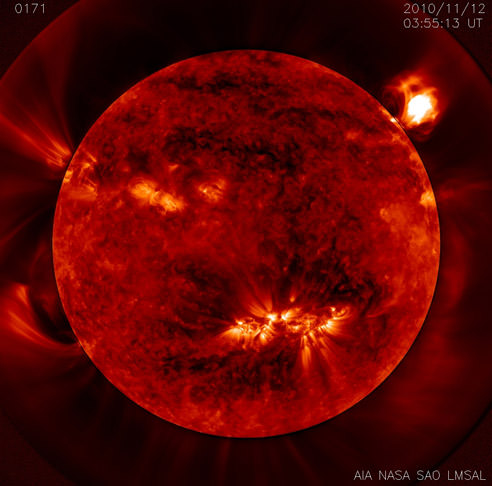


This pioneering mission meets basic needs of theNASA Solar Connections Initiative and is of fundamental significancein astrophysics since the Sun is the prototype for all other stars andis the only example that can be investigated in detail. This is the overall objective ofthe Solar Probe mission. There are several alternate scenarios for what may be found on thismission and each scenario is related to specific causes for coronal expansion.The ensemble of instruments on Solar Probe will link the enormous wealthof existing solar and coronal observations to the actual physical stateand dynamics of the solar corona and provide the specific information neededto distinguish between these scenarios. At minimum, the polar coronal holes are at their largest. (c) Solar minimum, similar to the configuration seen on the cover imageof this report.

The polar coronal holes are growing in size at this time and theglobal structure of the corona often appears “tilted” away from the rotationaxis (N). Plumes, however, exist at all times in coronalholes. (b) Declining phase of the solar cycle, also showing that coronal plumesoccur in the coronal holes. (a) Solar maximum when the Sun is covered by relatively small streamerswith small or nonexistent polar coronal holes. Schematic of evolution of the solar corona over the 11 year sunspotcycle. What are the magnetic field andsolar rotation like near the poles of the Sun, beneath the polar coronalholes?.What are the properties of the smalleststructures in coronal holes and streamers?.What is the cause of thefast solar wind? What is the cause of the slow solarwind?.What is the physics of the flowof energy through the Sun’s surface and into the solar atmosphere (corona)?.The unanswered questions in basic physical phenomena of the Sun thatwill be addressed by Solar Probe can be summarized as: Elsewhere, at 5-20 R S,Solar Probe will pass through coronal holes where fast solar wind originates,the plasma is collisionless and non-Maxwellian, and the plasma b<<1. At its perihelion of 4 solar radii (R S)Solar Probe will be immersed in bright equatorial streamers like thosevisible on the cover, where the plasma is dense and collision dominated,the plasma b>1 (ratio of thermal pressure tomagnetic pressure), the speed is subsonic, and where slow solar wind originatesin a way which has so far eluded understanding. Two perihelion passes areplanned, the first near the 2010 sunspot maximum and the second near the2015 sunspot minimum - when the solar corona will be similar to what isshown on cover of this report. Both imagingand in situ measurements will provide the first three dimensional viewof the corona, high spatial and temporal measurements of the plasma andmagnetic fields, and high resolution helioseismology and magnetic fieldobservations of the solar polar photosphere. It is being sent to the Sun because the physics of theflow of energy through the Sun’s surface and into its atmosphere and thecauses of both slow and fast solar wind are not understood. The Solar Probe will fly as close to the Sun’s surface as is technologicallyfeasible today. The Sun, Corona, and SPM The Sun, Corona and the Solar Probe Mission (Current Scientific Understanding andQuestions)


 0 kommentar(er)
0 kommentar(er)
